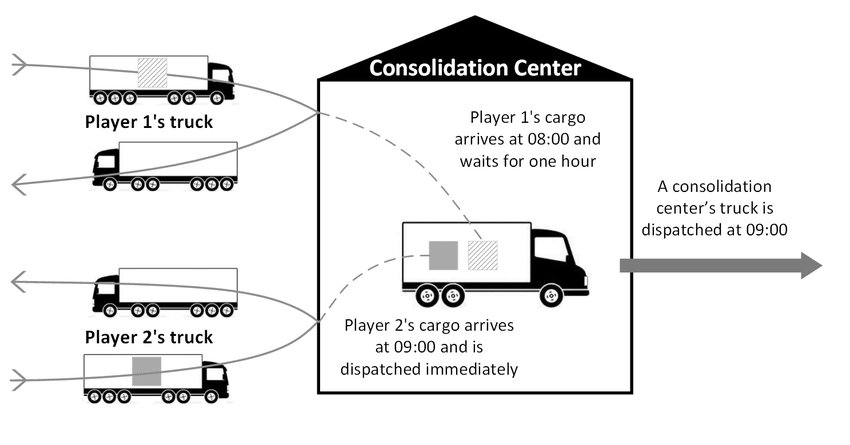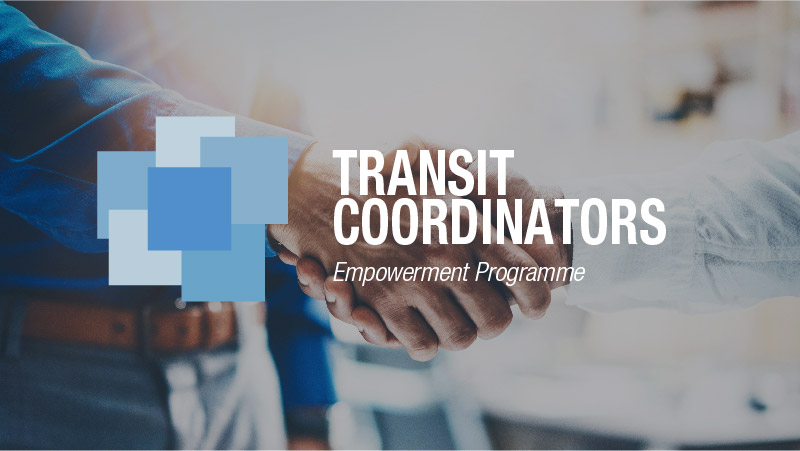Transport Consolidator (1 years diploma)
Transport Consolidator click here
Brief Job Description
Transport Consolidators are also known as Transport Order Mergers or Consolidators. Individuals in this
role typically consolidate smaller or numerous loads/ orders according to destination that pass through
their station or hub into outbound trucks for final delivery.
Personal Attributes
This job requires the individual to work well with various individuals including truck drivers, warehouse
representatives and route coordinators. The individual must be able to prioritize and execute tasks within
scheduled time limits. The individual should be able to maintain high concentration levels and have a
thorough understanding of routes and vehicle loads.

Plan and Schedule Deliveries
Description
This unit is about planning and scheduling deliveries.
Elements and Performance Criteria
Obtain information for scheduling deliveries
To be competent, the user/individual on the job must be able to:
PC1. obtain the schedule for trucks due to arrive for the day at the hub/consolidation station
PC2. note capacities of each truck and the available capacity based on load
PC3. obtain list of orders that are to be routed from current hub/consolidation station
PC4. note various locations to which deliveries are to be sent which are carried by the arrival
trucks
PC5. obtain list of trucks available for outbound deliveries and their capacities
Prepare schedule and delivery plan
To be competent, the user/individual on the job must be able to:
PC6. analyze delivery costs/transport costs for all orders
PC7. prepare budget for scheduled deliveries
PC8. determine optimal routes for trucks based on final destination for deliveries
PC9. determine carrier truck for each order/load based on capacity and destination of the out
bound truck
PC10. prepare detailed schedule and delivery plan for all the trucks scheduled to depart the same
day/next day
PC11. prepare chart for consolidating incoming loads into the respective trucks for delivery
PC12. coordinate with transport coordinator and warehouse in-charge to ensure truck consolidation
plan is as per original shipment plan
Knowledge and Understanding (KU)
The individual on the job needs to know and understand:
KU1. types of documentation in organization
KU2. procedures for consolidating orders as per client’s standard operating procedures
KU3. knowledge of organizational products and procedures
KU4. risk and impact of not following defined procedures/work instructions
KU5. knowledge of computer systems used for scheduling/logging in reports
KU6. knowledge of all relevant safety and security procedures
KU7. knowledge of Standard Operating Procedures (SOPs) and how to react in emergencies.
KU8. knowledge of procedure followed while booking trucks to pick up and transport
consignments
KU9. escalation matrix for reporting issues/challenges
KU10. contact details of relevant liaisons including head office coordinator, truck drivers, client
liaisons etc.
KU11. knowledge of transport companies the organization works with and their processes
KU12. knowledge of processes involved in inbound and outbound transport
KU13. knowledge of details required while consolidating orders
KU14. knowledge of distances to different destination
KU15. knowledge of pricing strategies in the market
KU16. knowledge of various routes that can be taken from hub/station
KU17. knowledge to use the computer for electronic documentation of information
KU18. types of workplace hazards that one can encounter on the job and safe operating practices
KU19. techniques for handling hazardous items and instructions on the same
KU20. methods for consolidating orders based on type, size, destination etc.
KU21. knowledge of possible common challenges and solutions for consolidating orders (delays,
low capacity utilization etc.)
Generic Skills (GS)
User/individual on the job needs to know how to:
GS1. prepare written delivery schedule and charts
GS2. fill out forms, inspection checklists pertaining to the customer consignments
GS3. prepare detailed reports for management.
GS4. read and follow instructions in the checklists, order lists etc.
GS5. read and understand instructions from the sop, drivers’ documentation
GS6. communicate clearly with managers, peers and other staff at the hub/station
GS7. regularly communicate with all employees to ensure activities are running smoothly
GS8. act objectively , rather than impulsively or emotionally when faced with difficult/stressful or
emotional situations
GS9. decide optimal pricing, routes and capacity for outbound trucks and determine consolidation
schedule accordingly
GS10. ability to make a judgment as to whether a customer order can be taken up or needs to be
dropped
GS11. adjust according to volume, capacity and manpower needs during peak and non-peak hours
GS12. prioritize and execute tasks within the scheduled time limits
GS13. maintain schedules and punctuality
GS14. flexibility to re-assess schedule in case of delays/additional orders
GS15. prepare schedules keeping in mind customer’s time lines and any special instructions from
the head office

GS16. understand the customer requirements and ensure that they are met
GS17. identify trends/common causes for errors and suggest possible solutions to the transport
manager
GS18. handle day to day problems like delays, staffing shortage, etc
GS19. suggest methods to streamline consolidation of orders
GS20. analyze costs (delivery, truck, time bound) to determine optimum costing for final deliveries
GS21. ability to assess the type of truck required for a particular load/destination
GS22. ability to count numbers and peform basic mathematics
GS23. ability to concentrate on task at hand and complete it without errors
Verify and Consolidate Deliveries
Description
This unit is about verifying and consolidating deliveries
Elements and Performance Criteria
Verify Orders on incoming trucks
To be competent, the user/individual on the job must be able to:
PC1. refer to arrival schedule and verify all trucks are on-time
PC2. note any delays in arrivals and update schedule accordingly
PC3. obtain verifications from unloading/loading supervisors on various loads
PC4. check for any errors/damages in goods and report the same to manager or head office
PC5. check goods for any hazardous material and follow appropriate handling techniques if
required
PC6. consult with driver on costs incurred on trip so far and verify the costs against the analyzed
budget
PC7. in case of deviation from anticipated costs, re-assess delivery routes and truck loads to
ensure optimal utilization of resources
PC8. once orders are verified, finalize the delivery plan prepared
Consolidate Deliveries
To be competent, the user/individual on the job must be able to:
PC9. based on chart/delivery plan prepared, instruct loaders / loading supervisor on moving
various loads to respective truck for final delivery
PC10. ensure orders are consolidated as per capacity and destination as outlined in the prepared
schedule
PC11. instruct drivers on destinations for deliveries as per schedule and clarify any queries or on
the job challenges faced
PC12. coordinate with head office to ensure all necessary documentation is available with the truck
driver
PC13. if there are any discrepancies, have them resolved with the head office/hub manager
PC14. in case of orders/deliveries that are delayed due to late arrival of remaining orders, report to
head office and follow instructions given
PC15. in case of orders/deliveries that are delayed due to pending orders/underutilization of vehicle
capacity, report to head office and follow instructions given
Knowledge and Understanding (KU)
The individual on the job needs to know and understand:
KU1. types of documentation in organization
KU2. consolidation process and procedure followed by organization
KU3. knowledge of organizational products and procedures
KU4. risk and impact of not following defined procedures/work instructions
KU5. knowledge of computer systems used for scheduling/logging in reports
KU6. knowledge of all relevant safety and security procedures
KU7. knowledge of Standard Operating Procedures (SOPs) and how to react in emergencies
KU8. knowledge of procedure followed while booking trucks to pick up and transport
consignments
KU9. escalation matrix for reporting issues/challenges
KU10. contact details of relevant liaisons including head office coordinator, truck drivers, client
liaisons etc.
KU11. knowledge of transport companies the organization works with and their processes
KU12. knowledge of processes involved in inbound and outbound transport
KU13. knowledge of details required while consolidating orders
KU14. knowledge of distances to different destination
KU15. knowledge of pricing strategies in the market
KU16. knowledge of various routes that can be taken from hub/station
KU17. knowledge to use the computer for electronic documentation of information
KU18. types of workplace hazards that one can encounter on the job and safe operating practices
KU19. methods for consolidating orders based on type, size, destination etc
KU20. techniques for handling hazardous materials and instructions on the same
KU21. knowledge of possible common challenges and solutions for consolidating orders (delays,
low capacity utilization etc.)
Generic Skills (GS)
User/individual on the job needs to know how to:
GS1. prepare written delivery schedule and charts
GS2. fill out forms, inspection checklists pertaining to the customer consignments
GS3. prepare detailed reports for management
GS4. read and follow instructions in the checklists, order lists etc
GS5. read and understand instructions from the sop, drivers’ documentation
GS6. communicate clearly with managers, peers and other staff at the hub/station
GS7. regularly communicate with all employees to ensure activities are running smoothly
GS8. act objectively , rather than impulsively or emotionally when faced with difficult/stressful or
emotional situations
GS9. decide optimal pricing, routes and capacity for outbound trucks and determine consolidation
schedule accordingly
GS10. ability to make a judgment as to whether a customer order can be taken up or needs to be
dropped

GS11. adjust according to volume, capacity and manpower needs during peak and non-peak hours
GS12. prioritize and execute tasks within the scheduled time limits
GS13. maintain schedules and punctuality
GS14. flexibility to re-assess schedule in case of delays/additional orders
GS15. prepare schedules keeping in mind customer’s time lines and any special instructions from
the head office
GS16. understand the customer requirements and ensure that they are met
GS17. identify trends/common causes for errors and suggest possible solutions to the transport
manager
GS18. handle day to day problems like delays, staffing shortage, etc
GS19. suggest methods to streamline consolidation of orders
GS20. analyze costs (delivery, truck, time bound) to determine optimum costing for final deliveries
GS21. ability to assess the type of truck required for a particular load/destination
GS22. ability to count numbers and peform basic mathematics
GS23. ability to concentrate on task at hand and complete it without errors
Peform Post Consolidation Activities
Description
This unit is about performing post-consolidation activities
Elements and Performance Criteria
Update delivery schedule in log books/information system
To be competent, the user/individual on the job must be able to:
PC1. Update all deliveries that have been successfully sent with outbound trucks and log in their
estimated dates of delivery as per schedule
PC2. Record any delays or pending deliveries’ details and reasons for delay
PC3. Update tracking information for each order so that it can be tracked by the consignment
tracking executive
PC4. Note any common issues faced by most trucks In order to identify possible solutions
Carry out reporting activities
To be competent, the user/individual on the job must be able to:
PC5. Report to head office on status of deliveries
PC6. Report any issues faced with respect to damaged goods, instructing drivers or any unforeseen
circumstances
PC7. Report to client/destination warehouse on approximate expected time and date of deliveries if
required
PC8. Prepare reports on the trend in delivery costs, driver stipends etc.
Knowledge and Understanding (KU)
The individual on the job needs to know and understand:
KU1. types of documentation in organization
KU2. knowledge of organizational products and procedures
KU3. risk and impact of not following defined procedures/work instructions
KU4. knowledge of computer systems used for scheduling/logging in reports
KU5. knowledge of all relevant safety and security procedures
KU6. knowledge of Standard Operating Procedures (SOPs) and how to react in emergencies.
KU7. knowledge of procedure followed while booking trucks to pick up and transport
consignments
KU8. escalation matrix for reporting issues/challenges
KU9. contact details of relevant liaisons including head office coordinator, truck drivers, client
liaisons etc.
KU10. knowledge of processes involved in inbound and outbound transport
KU11. knowledge of details required while consolidating orders
KU12. knowledge of distances to different destination.
KU13. knowledge of pricing strategies in the market
KU14. knowledge of various routes that can be taken from hub/station
KU15. knowledge to use the computer for electronic documentation of information.
KU16. types of workplace hazards that one can encounter on the job and safe operating practices
KU17. methods for consolidating orders based on type, size, destination etc.
KU18. knowledge of possible common challenges and solutions for consolidating orders (delays,
low capacity utilization etc.)
Generic Skills (GS)
User/individual on the job needs to know how to:
GS1. prepare written delivery schedule and charts
GS2. fill out forms, inspection checklists pertaining to the customer consignments
GS3. prepare detailed reports for management.
GS4. read and follow instructions in the checklists, order lists etc.
GS5. read and understand instructions from the sop, drivers’ documentation
GS6. communicate clearly with managers, peers and other staff at the hub/station
GS7. regularly communicate with all employees to ensure activities are running smoothly
GS8. act objectively , rather than impulsively or emotionally when faced with difficult/stressful or
emotional situations
GS9. decide optimal pricing, routes and capacity for outbound trucks and determine consolidation
schedule accordingly
GS10. ability to make a judgment as to whether a customer order can be taken up or needs to be
dropped
GS11. adjust according to volume, capacity and manpower needs during peak and non-peak hours
GS12. prioritize and execute tasks within the scheduled time limits
GS13. maintain schedules and punctuality.
GS14. flexibility to re-assess schedule in case of delays/additional orders
GS15. prepare schedules keeping in mind customer’s time lines and any special instructions from
the head office
GS16. understand the customer requirements and ensure that they are met
GS17. identify trends/common causes for errors and suggest possible solutions to the transport
manager
GS18. handle day to day problems like delays, staffing shortage, etc
GS19. suggest methods to streamline consolidation of orders
GS20. analyze costs (delivery, truck, time bound) to determine optimum costing for final deliveries
GS21. ability to assess the type of truck required for a particular load/destination
GS22. ability to count numbers and perform basic mathematical operations
GS23. ability to concentrate on task at hand and complete it without errors
Maintain Health, Safety and Security Measures during transport consolidation
Description
This unit is about health and safety measures
Elements and Performance Criteria
Maintain health, safety and security measures during all activities
To be competent, the user/individual on the job must be able to:
PC1. follow Material Safery Data Sheet (MSDS) and other security procedures as per company
policy.

PC2. follow all precautionary data handling procedures
PC3. maintain clean work table area.
PC4. ensure data privacy and independence in all dealings
PC5. in case of signs of any emergency situation or accident or breach of safety immediately follow
organizational protocol to deploy action
PC6. identify reasons for occurrence of incident
PC7. capture reasons and response/action taken into incident report/note to manager
PC8. report any deviations from standard protocol along with reasons (if any)
PC9. visually inspect the activity area and equipment for appropriate and safe condition
Knowledge and Understanding (KU)
The individual on the job needs to know and understand:
KU1. types of documentation in organization
KU2. knowledge of organizational products and procedures
KU3. risk and impact of not following defined procedures/work instructions
KU4. knowledge of computer systems used for scheduling/logging in reports
KU5. knowledge of all relevant safety and security procedures
KU6. knowledge of Standard Operating Procedures (SOPs) and how to react in emergencies
KU7. knowledge of procedure followed while booking trucks to pick up and transport
consignments
KU8. escalation matrix for reporting issues/challenges
KU9. contact details of relevant liaisons including head office coordinator, truck drivers, client
liaisons etc
KU10. knowledge of processes involved in inbound and outbound transport
KU11. knowledge of details required while consolidating orders
KU12. knowledge of distances to different destination.
KU13. knowledge of pricing strategies in the market
KU14. knowledge of various routes that can be taken from hub/station
KU15. knowledge to use the computer for electronic documentation of information
KU16. types of workplace hazards that one can encounter on the job and safe operating practices.
KU17. methods for consolidating orders based on type, size, destination etc
KU18. knowledge of possible common challenges and solutions for consolidating orders (delays,
low capacity utilization etc.)
Generic Skills (GS)
User/individual on the job needs to know how to:
GS1. prepare written delivery schedule and charts
GS2. fill out forms, inspection checklists pertaining to the customer consignments
GS3. prepare detailed reports for management.
GS4. read and follow instructions in the checklists, order lists etc.
GS5. read and understand instructions from the SOP, drivers’ documentation
GS6. communicate clearly with managers, peers and other staff at the hub/station
GS7. regularly communicate with all employees to ensure activities are running smoothly
GS8. act objectively , rather than impulsively or emotionally when faced with difficult/stressful or
emotional situations
GS9. decide optimal pricing, routes and capacity for outbound trucks and determine consolidation
schedule accordingly
GS10. ability to make a judgment as to whether a customer order can be taken up or needs to be
dropped
GS11. adjust according to volume, capacity and manpower needs during peak and non-peak hours
GS12. prioritize and execute tasks within the scheduled time limits
GS13. maintain schedules and punctuality
GS14. flexibility to re-assess schedule in case of delays/additional orders
GS15. prepare schedules keeping in mind customer’s time lines and any special instructions from
the head office
GS16. understand the customer requirements and ensure that they are met
GS17. identify trends/common causes for errors and suggest possible solutions to the transport
manager
GS18. handle day to day problems like delays, staffing shortage, etc
GS19. suggest methods to streamline consolidation of orders
GS20. analyze costs (delivery, truck, time bound) to determine optimum costing for final deliveries
GS21. ability to assess the type of truck required for a particular load/destination
GS22. ability to count numbers and perform basic mathematical operations
GS23. ability to concentrate on task at hand and complete it without errors
Employability Skills (60 Hours)
Description
This unit is about employability skills, Constitutional values, becoming a professional in the 21st Century,
digital, financial, and legal literacy, diversity and Inclusion, English and communication skills, customer
service, entrepreneurship, and apprenticeship, getting ready for jobs and career development.
Scope
The scope covers the following :
Introduction to Employability Skills
Constitutional values – Citizenship
Becoming a Professional in the 21st Century
Basic English Skills
Career Development & Goal Setting
Communication Skills
Diversity & Inclusion
Financial and Legal Literacy
Essential Digital Skills
Entrepreneurship
Customer Service
Getting ready for Apprenticeship & Jobs
Elements and Performance Criteria
Introduction to Employability Skills
To be competent, the user/individual on the job must be able to:
PC1. identify employability skills required for jobs in various industries
PC2. identify and explore learning and employability portals
Constitutional values – Citizenship
To be competent, the user/individual on the job must be able to:
PC3. recognize the significance of constitutional values, including civic rights and duties,
citizenship, responsibility towards society etc. and personal values and ethics such as
honesty, integrity, caring and respecting others, etc.
PC4. follow environmentally sustainable practices
Becoming a Professional in the 21st Century
To be competent, the user/individual on the job must be able to:
PC5. recognize the significance of 21st Century Skills for employment
PC6. practice the 21st Century Skills such as Self-Awareness, Behaviour Skills, time management,
critical and adaptive thinking, problem-solving, creative thinking, social and cultural
awareness, emotional awareness, learning to learn for continuous learning etc. in personal
and professional life
Basic English Skills
To be competent, the user/individual on the job must be able to:
PC7. use basic English for everyday conversation in different contexts, in person and over the
telephone
PC8. read and understand routine information, notes, instructions, mails, letters etc. written in
English

PC9. write short messages, notes, letters, e-mails etc. in English
Career Development & Goal Setting
To be competent, the user/individual on the job must be able to:
PC10. understand the difference between job and career
PC11. prepare a career development plan with short- and long-term goals, based on aptitude
Communication Skills
To be competent, the user/individual on the job must be able to:
PC12. follow verbal and non-verbal communication etiquette and active listening techniques in
various settings
PC13. work collaboratively with others in a team
Diversity & Inclusion
To be competent, the user/individual on the job must be able to:
PC14. communicate and behave appropriately with all genders and PwD
PC15. escalate any issues related to sexual harassment at workplace according to POSH Act
Financial and Legal Literacy
To be competent, the user/individual on the job must be able to:
PC16. select financial institutions, products and services as per requirement
PC17. carry out offline and online financial transactions, safely and securely
PC18. identify common components of salary and compute income, expenses, taxes, investments
etc
PC19. identify relevant rights and laws and use legal aids to fight against legal exploitation
Essential Digital Skills
To be competent, the user/individual on the job must be able to:
PC20. operate digital devices and carry out basic internet operations securely and safely
PC21. use e- mail and social media platforms and virtual collaboration tools to work effectively
PC22. use basic features of word processor, spreadsheets, and presentations
Entrepreneurship
To be competent, the user/individual on the job must be able to:
PC23. identify different types of Entrepreneurship and Enterprises and assess opportunities for
potential business through research
PC24. develop a business plan and a work model, considering the 4Ps of Marketing Product, Price,
Place and Promotion
PC25. identify sources of funding, anticipate, and mitigate any financial/ legal hurdles for the
potential business opportunity
Customer Service
To be competent, the user/individual on the job must be able to:
PC26. identify different types of customers
PC27. identify and respond to customer requests and needs in a professional manner.
PC28. follow appropriate hygiene and grooming standards
Getting ready for apprenticeship & Jobs
To be competent, the user/individual on the job must be able to:
PC29. create a professional Curriculum vitae (Résumé)
PC30. search for suitable jobs using reliable offline and online sources such as Employment
exchange, recruitment agencies, newspapers etc. and job portals, respectively
PC31. apply to identified job openings using offline /online methods as per requirement
PC32. answer questions politely, with clarity and confidence, during recruitment and selection
PC33. identify apprenticeship opportunities and register for it as per guidelines and requirements
Knowledge and Understanding (KU)
The individual on the job needs to know and understand:
KU1. need for employability skills and different learning and employability related portals
KU2. various constitutional and personal values
KU3. different environmentally sustainable practices and their importance
KU4. Twenty first (21st) century skills and their importance
KU5. how to use English language for effective verbal (face to face and telephonic) and written
communication in formal and informal set up
KU6. importance of career development and setting long- and short-term goals
KU7. about effective communication
KU8. POSH Act
KU9. Gender sensitivity and inclusivity
KU10. different types of financial institutes, products, and services
KU11. how to compute income and expenditure
KU12. importance of maintaining safety and security in offline and online financial transactions
KU13. different legal rights and laws
KU14. different types of digital devices and the procedure to operate them safely and securely
KU15. how to create and operate an e- mail account and use applications such as word processors,
spreadsheets etc.
KU16. how to identify business opportunities
KU17. types and needs of customers

KU18. how to apply for a job and prepare for an interview
KU19. apprenticeship scheme and the process of registering on apprenticeship portal
Generic Skills (GS)
User/individual on the job needs to know how to:
GS1. read and write different types of documents/instructions/correspondence
GS2. communicate effectively using appropriate language in formal and informal settings
GS3. behave politely and appropriately with all
GS4. how to work in a virtual mode
GS5. perform calculations efficiently
GS6. solve problems effectively
GS7. pay attention to details
GS8. manage time efficiently
GS9. maintain hygiene and sanitization to avoid infection








